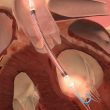TAVR has been shown beneficial over time, and with the development of new generation of prosthetic valves and implantation techniques, outcomes have been improved, reducing the incidence of leaks y and the need for definite pacemaker. This study looked at the evolution of 100 patients with symptomatic aortic stenosis treated with Myval THV from Meril...
Predictors of Stroke at 30 Days and 6 Months After TAVR
While the rate of stroke has decreased since the early days of transcatheter aortic valve replacement (TAVR), it remains non-negligible, reaching up to 1%-3% at 30 days. As TAVR progressively expands to low-risk populations and younger patients, identifying risk factors for patient selection and management in stroke prevention becomes crucial. While researchers have identified predictors...
Low Gradient, Normal Flow Aortic Stenosis: Changes in Quality of Life with TAVR
There is no question as regards the recommended treatment for symptomatic severe aortic stenosis, seeing as both transcatheter and surgical aortic valve replacement (TAVR and SAVR) have shown to significantly improve prognosis. This is despite the fact that there is still certain ambiguity around its characterization, which looks to define it according to hemodynamic severity...
CAPTIS, a Novel Cerebral Embolic Protection System in TAVR
The incidence of stroke after TAVR ranges between 2 and 5%, depending on the series, which has been associated with higher morbimortality, affecting patient quality of life and their psycho-social environment. Many cerebral embolic protection systems have been developed in response, and even though they have been shown beneficial in many studies, their role in...
Cerebral Embolic Protection Devices: How Useful are they in TAVR?
During TAVR, we often fear the possibility of a stroke, which occurs in approximately 1 – 2% of cases. In general, this phenomenon is caused by thrombi stemming from atherosclerotic or calcified plaque, depending on the etiology. Even though its incidence has declined with technology development and the increasing expertise of operators, it is still...
Is TAVR Beneficial in Cardiogenic Shock?
The presence of cardiogenic shock (CS) in a setting of aortic stenosis ranges from 1% to 4%. The prognosis for this scenario is ominous due to subendocardial ischemia, which presents as a decrease in ventricular preload and an increase in afterload. Aortic valvuloplasty has been used in this context, but, unfortunately, it has been associated...
Impella in High Risk Coronary Angioplasty before TAVR
The population is aging, which is closely related with the presence of aortic stenosis. This condition, as we know, is associated with coronary artery disease (CAD) approximately in 50% of cases. In high risk surgical patients, this calls for procedures such as percutaneous coronary intervention (PCI) and transcatheter aortic valve replacement (TAVR). PCI with ventricular...
TCT 2023 | VIVA Trial: TAVR vs. SAVR in Patients with Severe Aortic Stenosis and Small Aortic Annulus
Degenerative aortic stenosis (AS) is the most common valve condition. A significant number of AS patients presents a small aortic annulus (SAA), especially women. Treating this group of patients remains challenging, seeing as they have a high incidence of suboptimal hemodynamic results. Despite the development of TAVR (transcatheter aortic valve replacement), the current guidelines do...
TCT 2023 | The WATCH-TAVR Study
In the TVT registry, around 40% of the patients eligible for transcatheter aortic valve replacement (TAVR) had atrial fibrillation, and there were high levels of adverse events after starting anticoagulant treatment, especially with oral anticoagulants (VKAs), primarily due to bleeding. The purpose of this study was to assess the feasibility, safety, and efficacy of combined...
OBSERVANT II: Post TAVR 30-Day and 6-Month Stroke Predictors
Despite stroke rate has declined since the early days of transcatheter aortic valve replacement (TAVR), it remains significant, reaching 1% to 3% 30 days after procedure. Since TAVR has seen a progressive expansion to the low risk and young populations, identifying risk factors in patient selection and management is crucial for us to prevent stroke. ...







